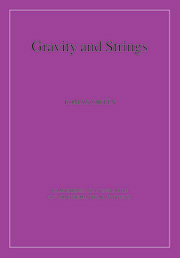Book contents
- Frontmatter
- Contents
- Preface
- Part I Introduction to gravity and supergravity
- Part II Gravitating point-particles
- 7 The Schwarzschild black hole
- 8 The Reissner–Nordström black hole
- 9 The Taub–NUT solution
- 10 Gravitational pp-waves
- 11 The Kaluza–Klein black hole
- 12 Dilaton and dilaton/axion black holes
- 13 Unbroken supersymmetry
- Part III Gravitating extended objects of string theory
- Appendix A Lie groups, symmetric spaces, and Yang–Mills fields
- Appendix B Gamma matrices and spinors
- Appendix C n-Spheres
- Appendix D Palatini's identity
- Appendix E Conformal rescalings
- Appendix F Connections and curvature components
- Appendix G The harmonic operator on ℝ3 × S1
- References
- Index
7 - The Schwarzschild black hole
Published online by Cambridge University Press: 20 February 2010
- Frontmatter
- Contents
- Preface
- Part I Introduction to gravity and supergravity
- Part II Gravitating point-particles
- 7 The Schwarzschild black hole
- 8 The Reissner–Nordström black hole
- 9 The Taub–NUT solution
- 10 Gravitational pp-waves
- 11 The Kaluza–Klein black hole
- 12 Dilaton and dilaton/axion black holes
- 13 Unbroken supersymmetry
- Part III Gravitating extended objects of string theory
- Appendix A Lie groups, symmetric spaces, and Yang–Mills fields
- Appendix B Gamma matrices and spinors
- Appendix C n-Spheres
- Appendix D Palatini's identity
- Appendix E Conformal rescalings
- Appendix F Connections and curvature components
- Appendix G The harmonic operator on ℝ3 × S1
- References
- Index
Summary
With this chapter we start the study of a number of important classical solutions of GR. There is no doubt that the most important solution is Schwarzschild's, that describes the static, spherically symmetric gravitational field in the absence of matter that one finds outside any static, spherically symmetric object (star, planet …). It is this, the simplest nontrivial solution that leads to the concept of a black hole (BH), which affords a privileged theoretical laboratory for Gedankenexperimente in classical and quantum gravity.
It is, in fact, a firmly established belief in our scientific community that macroscopic BHs (of the size studied by astrophysicists) are the endpoints of gravitational collapse of stars, which, after a long time, gives rise to Schwarzschild BHs if the stars do not rotate. There should be many macroscopic Schwarzschild BHs in our Universe, since many stars have enough mass to undergo gravitational collapse and there is evidence of supermassive BHs in the centers of galaxies. It has been suggested that smaller BHs could have been produced in the Big Bang. Here we are going to be interested in BHs of all sizes, independently of their origin (primordial, quantum-mechanical, astrophysical …).
We begin by deriving the Schwarzschild solution and studying its classical properties in order to find its physical interpretation. The physical interpretation of vacuum solutions of the Einstein equations is a most important and complicated point (see [168, 169]) since the source, located by definition in the region in which the vacuum Einstein equations are not solved, is unknown. In the case of the Schwarzschild solution, we will be led to the new concepts of the event horizon and BHs.
- Type
- Chapter
- Information
- Gravity and Strings , pp. 187 - 212Publisher: Cambridge University PressPrint publication year: 2004

